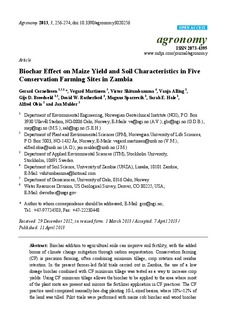| dc.description.abstract | Biochar addition to agricultural soils can improve soil fertility, with the added bonus of climate change mitigation through carbon sequestration. Conservation farming (CF) is precision farming, often combining minimum tillage, crop rotation and residue retention. In the present farmer-led field trials carried out in Zambia, the use of a low dosage biochar combined with CF minimum tillage was tested as a way to increase crop yields. Using CF minimum tillage allows the biochar to be applied to the area where most of the plant roots are present and mirrors the fertilizer application in CF practices. The CF practice used comprised manually hoe-dug planting 10-L sized basins, where 10%–12% of the land was tilled. Pilot trials were performed with maize cob biochar and wood biochar on five soils with variable physical/chemical characteristics. At a dosage as low as 4 tons/ha, both biochars had a strong positive effect on maize yields in the coarse white aeolian sand of Kaoma, West-Zambia, with yields of 444% ± 114% (p = 0.06) and 352% ± 139% (p = 0.1) of the fertilized reference plots for maize and wood biochar, respectively. Thus for sandy acidic soils, CF and biochar amendment can be a promising combination for increasing harvest yield. Moderate but non-significant effects on yields were observed for maize and wood biochar in a red sandy clay loam ultisol east of Lusaka, central Zambia (University of Zambia, UNZA, site) with growth of 142% ± 42% (p > 0.2) and 131% ± 62% (p > 0.2) of fertilized reference plots, respectively. For three other soils (acidic and neutral clay loams and silty clay with variable cation exchange capacity, CEC), no significant effects on maize yields were observed (p > 0.2). In laboratory trials, 5% of the two biochars were added to the soil samples in order to study the effect of the biochar on physical and chemical soil characteristics. The large increase in crop yield in Kaoma soil was tentatively explained by a combination of an increased base saturation (from <50% to 60%–100%) and cation exchange capacity (CEC; from 2–3 to 5–9 cmol/kg) and increased plant-available water (from 17% to 21%) as well as water vapor uptake (70 mg/g on maize cob biochar at 50% relative humidity). | nb_NO |

